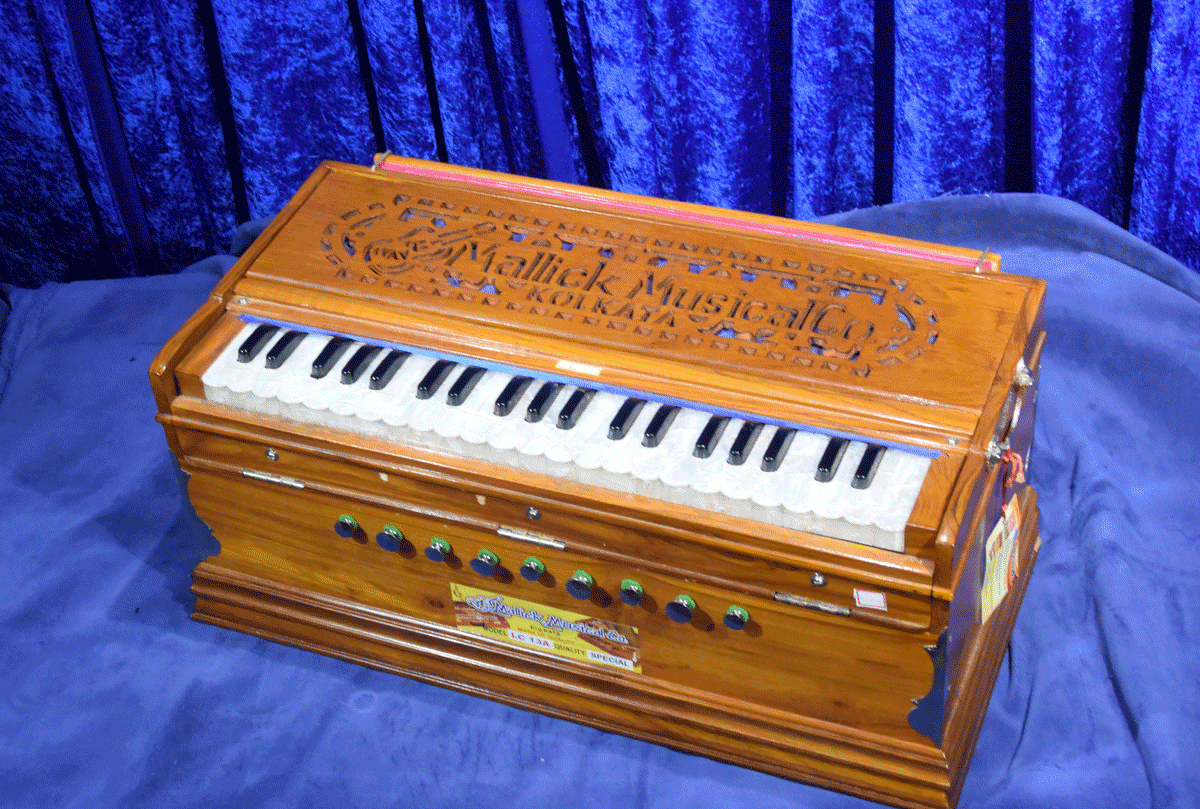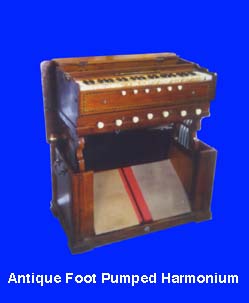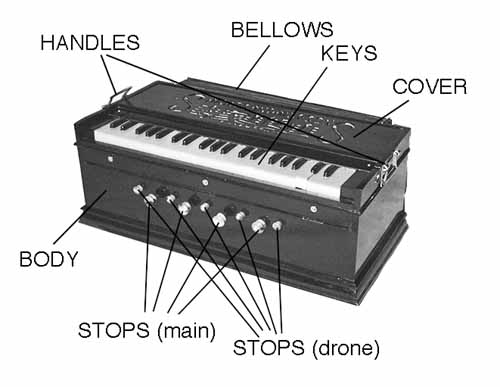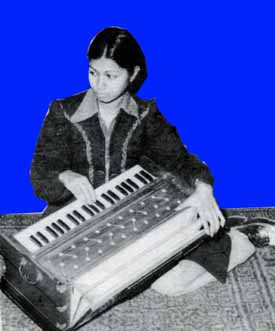
The harmonium is also known as peti or baja. This instrument is not a native Indian instrument. It is a European instrument which was imported in the 19th century. It is a reed organ with hand pumped bellows. Although it is a relatively recent introduction, it has spread throughout the subcontinent. Today, it is used in virtually every musical genre except the south Indian classical.

Although this is a European invention, it has evolved into a truly bi-cultural instrument. The keyboard is European, but it has a number of drone reeds which are particularly Indian. European models came in both hand pumped and foot pumped models. The foot pumped models disappeared in India many years ago. This is because the foot pedals required one to sit in a chair; something which is unusual for an Indian musician. Also the only advantage of the foot model was that it freed both hands so that both melody and chords could be played. Indian music has no chords, so this was no advantage. Although the hand pumped models required one hand to pump they were more portable and comfortable when played on the floor.
There is an instrument which is very similar to the harmonium, but it has no keys. It therefore, is incapable of playing a melody and must merely play a drone. This is called a surpeti.
Parts of Harmonium
There are a number of parts of the harmonium, here are some of the main ones:

Body – The body is the box that houses the various parts of the harmonium. There are two basic styles. One style is simply a box with everything in a fixed position (see above illustration). Another style collapses down into a suitcase style of enclosure. There are several collapsible styles; one is shown below.

Bellows – The bellows are the pumps which force the air through the instrument. There are really two sets of bellows, one internal and one external. The external bellows are pumped by hand; these are familiar to the average player. The external bellows then forces the air into the internal bellows. The internal bellows act as a reservoir for the air. These bellows lay deep inside the instrument and are visible only by disassembling the instrument. The internal bellows push against a spring; it is this spring which forces the air over the reeds.
Keys – The keys, known in India as “chabi”, are the small wooden controls that the performer fingers to play the music. There are black keys and white keys. Although the keyboard is reminiscent of the keyboards found on pianos and other Western instruments, the international standard for pitch (i.e., A=440) has not been adopted.
Cover – The cover is a small piece of wood, sometimes with cloth or glass, which covers the workings of the harmonium. It serves two functions. The most important is to protect the workings against damage. It also changes the sound by muting the higher frequencies while allowing the lower frequencies to pass. Sometimes the cover has a sliding panel which makes this muting action adjustable.
Stops (main) – The main stops are a series of valves which control the way that air flows in the instrument. The main stops control the air flowing into the various reed chambers. There are usually a minimum of one stop per reed chamber; however it is not unusual to find more than one per chamber. Although these extra stops may control special functions, such as tremolo, it is not unusual to find a redundant stops with no special function. This reflects the tendency of Indian musicians to simply open up all the stops, regardless of the function.
Stops (drone) – The drone strops are the most distinguishing feature of Indian harmoniums. These stops control the flow of air over un-keyed reeds. They simply drone their particular pitch. There may be any number of drones set to any pitch; however they tend toward, A sharp, C sharp, D sharp, F sharp, and G sharp.
Handles – The handles allow for easy transport of the harmonium. In a box type, there are two handles on the sides. In a suitcase style, there is only a single handle.
Reeds (not shown) – The reeds a series of brass reeds set into a heavier brass base. Each base is roughly 1/4 inch by 2 inches. There must be a minimum of one reed per key while two or three are the most common. These small brass reeds vibrate whenever air passes over them.
Coupler (not shown) – A coupler is a mechanical arrangement whereby another key is played along with the one being fingered. Normally it is the key located an octave below the selected key. This arrangement produces a much richer sound than an uncoupled keyboard. This coupling may be enabled or defeated by the user.
Scale Changer (not shown) – Scale changer is an elaborate mechanical arrangement whereby the entire keyboard may be shifted up or down. This allows a musician to transpose the performance into any key without having to learn new fingerings. WARNING – Do not buy a scale changing harmonium. The failure rate is unacceptable!
Reed Board (not shown) – The reed board is a flat piece of wood with a series of long holes cut in them. There are a series of brass reeds covering these holes. These reeds are arranged in banks. If there are two banks of reeds, it is said to be a double-reed harmonium. If there are three banks of reeds, it is said to be a triple-reed harmonium. The triple-reed harmonium is generally considered to be superior to the double-reed variety. Sometimes this board is not flat, but instead has the reeds set into perpendicular baffles. This style is said to produce a better sound.
| THESE BOOKS MAY NOT BE FOR YOU |
|---|
A superficial exposure to music is acceptable to most people; but there is an elite for whom this is not enough. If you have attained certain social and intellectual level, Elementary North Indian Vocal (Vol 1-2) may be for you. This has compositions, theory, history, and other topics. All exercises and compositions have audio material which may be streamed over the internet for free. It is available in a variety of formats to accommodate every budget. Are you really ready to step up to the next level? Check your local Amazon. |
Playing Position

Standard Sitting Position
Qawwali Sitting Position
There are two common sitting positions, a standard position and one used by qawwali singers. The standard position is simple. On simply places the harmonium on the ground. The right hand plays the keys while the left hand pumps the bellows. This is the most common position used in India today. There is also a position used by qawwali singers and folk musicians. For this position one end of the harmonium rests on the ground while the other end rest partially in the lap. Both positions are illustrated in the above pictures.
The position is reversed for left handed musicians. In such cases the right hand pumps the bellows while the left hand plays the melody.
The harmonium may also be played standing and walking. In this case the harmonium is slung by a strap around the neck. This however, seems to be limited to beggars that one may occasionally encounter.